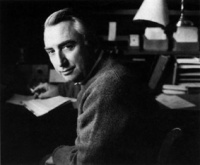Roland Barthes
From Geography
| Line 1: | Line 1: | ||
| - | [[File:Roland_Barthes.jpg|200px|thumb|left| | + | [[File:Roland_Barthes.jpg|200px|thumb|left|Roland Barthes]] |
Roland Barthes (1915-80) was a critical cultural thinker, and a central figure in the study of [[language]], literature, culture and the media, both as innovator and guide. His work has been influential in e.g. [[structuralism]], [[semiology]] and [[poststructuralism]] (Allen, 2003). | Roland Barthes (1915-80) was a critical cultural thinker, and a central figure in the study of [[language]], literature, culture and the media, both as innovator and guide. His work has been influential in e.g. [[structuralism]], [[semiology]] and [[poststructuralism]] (Allen, 2003). | ||
Latest revision as of 20:25, 24 October 2012
Roland Barthes (1915-80) was a critical cultural thinker, and a central figure in the study of language, literature, culture and the media, both as innovator and guide. His work has been influential in e.g. structuralism, semiology and poststructuralism (Allen, 2003).
Contents |
Work
Barthes studied French literature and cultural studies in Paris. Later he became a professor in literature semiology at the prestegious College de France (Heijloo & Eskens, 2005). He was a post war cultural critic, obsessed by language. He investigated different ways of using language using the semiotics of Ferdinand de Saussure. He developed de Saussure's 'linguistic model' in a much wider field of signs and representations, such as in advertising, photography, architecture, design, fashion etc. (Hall, 1997). These semiotics seem to be a 'metalanguage', but in fact also are an interpretation of 'reality', or a form of giving meaning. Thereby he announced 'the dead of the author', because only through the reader a text could gain its meaning. One of his most famous works is 'Mythodologies' (1957).
Human Geography
In the field of Human Geography Barthes became used by Duncan and Duncan (1992). They used him as a way-station in their journey towards reading Landscape not as morphology but as text, out of literary theory that seeks to expose the enduring and underlying structures inscribed in the cultural practices of human subjects (Gregory, Johnston, Pratt, Watts, Whatmore, 2009)
References
- Allen, G. (2003) Roland Barthes. Routledge, London
- Gregory, D., Johnston, R., Pratt, G., Watts, M. and Whatmore, S. (2009) The dictionary of human geography, Wiley-Blackwell, Chicester
- Hall, S. (1997) Representation: Cultural representations and signifying practices. Sage publications, London
- Heijloo, R., Eskens, E., (2005) Filosofen lexicon, Veen Magazines, Diemen
Contributors
- Page created by Anne van Strien --AnneStrien 17:30, 2 October 2012 (CEST)
- Page edited and links added by Isis Boot - --IsisBoot 17:07, 23 October 2012 (CEST)
- Picture added by Isis Boot - --IsisBoot 18:13, 24 October 2012 (CEST)
